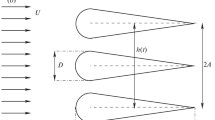Abstract
Aerodynamic force and flow structures of two airfoils in a tandem configuration in flapping motions are studied, by solving the Navier-Stokes equations in moving overset grids. Three typical phase differences between the fore- and aftairfoil flapping cycles are considered. It is shown that: (1) in the case of no interaction (single airfoil), the time average of the vertical force coefficient over the downstroke is 2.74, which is about 3 times as large as the maximum steady-state lift coefficient of a dragonfly wing; the time average of the horizontal force coefficient is 1.97, which is also large. The reasons for the large force coefficients are the acceleration at the beginning of a stroke, the delayed stall and the “pitching-up” motion near the end of the stroke. (2) In the cases of two-airfoils, the time-variations of the force and moment coefficients on each airfoil are broadly similar to that of the single airfoil in that the vertical force is mainly produced in downstroke and the horizontal force in upstroke, but very large differences exist due to the interaction. (3) For in-phase stroking, the major differences caused by the interaction are that the vertical force on FA in downstroke is increased and the horizontal force on FA in upstroke decreased. As a result, the magnitude of the resultant force is almost unchanged but it inclines less forward. (4) For counter stroking, the major differences are that the vertical force on AA in downstroke and the horizontal force on FA in upstroke are decreased. As a result, the magnitude of the resultant force is decreased by about 20 percent but its direction is almost unchanged. (5) For 90°-phase-difference stroking, the major differences are that the vertical force on AA in downstroke and the horizontal force on FA in upstroke are decreased greatly and the horizontal force on AA in upstroke increased. As a result, the magnitude of the resultant force is decreased by about 28% and it inclines more forward. (6) Among the three cases of phase angles, inphase flapping produces the largest vertical force (also the largest resultant force); the 90°-phase-difference flapping results in the largest horizontal force, but the smallest resultant force.
Similar content being viewed by others
References
Alexander DE. Unusual phase relationships between the forewings and hindwings in flying dragonflies.J Exp Biol, 1984, 109: 379–383
Norberg RA. Hovering flight of the dragonfly Aeschna juncea L., kinematics and aerodynamics. In Swimming and Flying in Nature Wu TY, Brokaw CJ, Brennen C, eds. New York: Plenum Press, 1975. 763–781
Wakenling JM, Ellington CP. Dragonfly flight, II. velocities, accelerations and kinematics of flapping flight.J Exp Biol, 1997, 200: 557–582
Weis-Fogh T. Quick estimates of flight fitness in hovering animals, including novel mechanisms for lift production.J Exp Biol, 1973, 59: 169–230
Somps C, Luttges M. Dragonfly flight: novel uses of unsteady separation flows.Science, 1985, 28: 1326–1328
Saharon D, Luttges M. Dragonfly unsteady aerodynamics: the role of the wing phase relations in controlling the produced flows. AIAA Paper 89-0832, 1989
Saharon D, Luttges M. Visualization of unsteady separated flow produced by mechanically driven dragonfly wing kinematics model. AIAA Paper 88-0569, 1988
Rogers SE, Kwak D, Kiris C. Numerical solution of the incompressible Navier-Stokes equations for steady-state and time-dependent problems.AIAA Journal, 1991, 29: 603–610
Lan SL, Sun M. Aerodynamic properties of a wing performing unsteady rotational motions at low Reynolds number.Acta Mechanica, 2001, 149: 1–13
Meakin R. Moving body overset grid methods for complete aircraft tiltrotor simulations. AIAA Paper 93-3350, 1993
Hilgenstock A. A fast method for the elliptic generation of three dimensional grids with full boundary control. In: Num Grid Generation in CFM'88. Pineridge Press Ld, 1988. 137–146
Hamdani H, Sun M. Aerodynamic forces and flow structures of an airfoil in some unsteady motions at low Reynolds number.Acta Mechanica, 2000, 145: 173–187
Wekeling JM, Ellington CP. Dragonfly flight, I. Gliding flight and steady-state aerodynamic forces.J Exp Biol, 1997, 200: 543–556
Author information
Authors and Affiliations
Rights and permissions
About this article
Cite this article
Shilong, L., Mao, S. Aerodynamic force and flow structures of two airfoils in flapping motions. Acta Mech Sinica 17, 310–331 (2001). https://doi.org/10.1007/BF02487459
Received:
Revised:
Issue Date:
DOI: https://doi.org/10.1007/BF02487459




